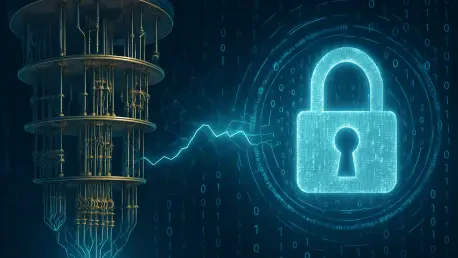Imagine a world where the digital locks safeguarding sensitive business data, from customer records to financial transactions, are suddenly rendered useless by a technological leap so profound that it rewrites the rules of cybersecurity. This scenario is not a distant sci-fi plot but a looming reality with the advent of quantum computers. Experts, as reported by RAND, predict that by the 2030s, these powerful machines could break through the encryption standards that protect much of today’s digital infrastructure. While this breakthrough remains on the horizon, the implications are already sending ripples through national security circles and corporate boardrooms alike. The potential for quantum systems to decrypt everything from VPN traffic to disaster recovery backups poses a direct threat to every organization relying on secure communications. This pressing challenge demands attention now, as the clock ticks toward a future where data privacy could become a relic of the past unless proactive measures are taken.
1. Understanding the Quantum Threat to Encryption
The foundation of modern cybersecurity rests on encryption methods like RSA, which depend on mathematical problems too complex for classical computers to solve within a reasonable timeframe. These methods secure everything from online banking to confidential emails, ensuring data remains inaccessible to unauthorized parties. However, quantum computers operate on principles of quantum mechanics, allowing them to tackle these problems at unprecedented speeds. Research highlighted by MIT Technology Review suggests that a quantum computer with 20 million noisy qubits could dismantle RSA-2048 encryption in a mere 8 hours. This stark contrast to the centuries it would take classical systems underscores the urgency of the issue. While such powerful quantum machines are not yet operational, their development is progressing rapidly in labs at companies like IBM and Google. The SANS Institute labels this an imminent threat, emphasizing that the timeline for preparedness is shrinking faster than many realize.
Beyond the technical challenge, the broader implications for businesses are staggering. Sensitive data with long retention periods, such as patient records or financial audits, faces significant risk if quantum computers become capable of decryption sooner than expected. The Global Risk Institute warns that a cryptographically relevant quantum computer could break standard protocols in under 24 hours. Meanwhile, malicious actors are already harvesting encrypted data, storing it for future exploitation once quantum tools are ready. This “harvest now, decrypt later” strategy means that information protected today could be vulnerable tomorrow. Organizations must recognize that this is not a distant problem but a current concern, especially for industries handling data with decades-long confidentiality requirements. The intersection of advancing technology and cybercrime creates a perfect storm, demanding immediate attention to safeguard critical assets from future breaches.
2. Exploring the Rise of Post-Quantum Cryptography
Amid the looming threat of quantum computing, a promising solution has emerged in the form of post-quantum cryptography (PQC). Unlike traditional encryption, PQC is built on mathematical problems that even quantum systems struggle to solve, offering a defense that can be implemented on existing hardware. This means organizations do not need to acquire quantum computers themselves to protect data, making the transition more accessible. In August 2024, the National Institute of Standards and Technology (NIST) finalized three key standards to combat this threat: FIPS 203 (ML-KEM) for general encryption, FIPS 204 (ML-DSA) for digital signatures, and FIPS 205 (SLH-DSA) for hash-based signatures. Additionally, a backup algorithm known as HQC was introduced to ensure diversity in cryptographic approaches. These standards serve as direct replacements for current methods like RSA, providing a robust shield against future quantum attacks.
While PQC offers hope, it comes with practical considerations for implementation. These algorithms demand larger key sizes and greater processing power compared to existing systems, though the performance impact remains minimal on modern hardware—often measured in milliseconds rather than minutes. Major technology vendors are already integrating PQC into their offerings, with Microsoft rolling out preview support for Windows and cloud providers updating their services accordingly. This industry momentum signals that the infrastructure for a broader transition is taking shape, reducing the burden on individual organizations to develop solutions from scratch. However, adopting PQC is not just a technical upgrade; it requires strategic planning to ensure seamless integration across diverse systems. Businesses must stay informed about these developments to align their security measures with evolving standards and protect data from emerging quantum capabilities.
3. Conducting a Quantum Readiness Assessment
Before any defense against quantum threats can be mounted, a thorough understanding of an organization’s current cryptographic landscape is essential. This begins with identifying where encryption is deployed across the infrastructure, encompassing everything from VPN concentrators and web servers to legacy database systems. Certificates, SSH keys, and encrypted application connections must also be accounted for in this inventory. While this process may seem daunting, it is a critical first step to avoid overlooking vital components that could become vulnerabilities when quantum computers advance. Tools such as network scanners and certificate management platforms can assist in discovery, though manual effort may be necessary for older applications or hardware appliances. The goal is to create a comprehensive map of cryptographic assets, ensuring no system is left unprotected as the transition to quantum-resistant solutions begins.
Once the scope of encryption usage is clear, prioritization becomes the next focus. Systems handling sensitive data with long-term confidentiality needs, such as health records or financial information, should be addressed first. Less critical systems, like outdated test servers, can be deferred to later phases. Documentation is key during this assessment, even if the initial findings are incomplete. Using simple tools like spreadsheets to log discoveries provides a foundation for further planning, avoiding the trap of striving for perfection at the outset. Many organizations struggle to locate all their sensitive data, but starting with visible assets and building from there is a practical approach. This readiness assessment not only highlights areas of risk but also informs the strategic allocation of resources, ensuring that efforts are directed where they are most needed to mitigate the impact of future quantum breakthroughs on data security.
4. Developing a Strategic PQC Migration Roadmap
Transitioning to post-quantum cryptography requires a well-structured roadmap to manage the complexity of such a significant shift in security protocols. The UK’s National Cyber Security Centre provides useful benchmarks, suggesting completion of discovery by 2028, high-priority migrations by 2031, and full transition by 2035. These timelines may appear generous, but past cryptographic migrations have spanned over a decade, and PQC impacts nearly every digital system. To begin, assigning a dedicated project lead ensures accountability and focus throughout the process. Starting an initial inventory, even if partial, establishes a baseline for action, while engaging vendors to clarify their PQC support plans helps identify potential gaps or delays. If vendors are unresponsive or vague, this signals a need to explore alternative solutions or partnerships to maintain progress toward quantum resilience.
Implementation should be phased based on risk and feasibility to minimize disruption. Testing PQC on new or non-production systems first allows for refinement without jeopardizing critical operations. Internal tools can follow, before extending to customer-facing systems, with hybrid setups combining classical and quantum-resistant methods to ensure compatibility during the transition. Budgeting for this shift is also crucial, as costs for new certificates, updated hardware, and consulting services will accumulate. Delaying financial planning risks higher expenses when quantum threats become urgent, forcing rushed and costly upgrades. By approaching migration strategically, organizations can balance immediate needs with long-term security goals, ensuring a smoother journey to a post-quantum future. This proactive stance mitigates risks and positions businesses to adapt as quantum computing continues to evolve.
5. Taking Action Before the Quantum Deadline
Reflecting on the path forward, it is clear that the urgency to address quantum computing threats was recognized well before they fully materialized. The groundwork laid by NIST with the release of PQC standards in 2024 marked a pivotal moment, equipping organizations with tools to defend against future decryption risks. Companies that took early steps to inventory their cryptographic assets and prioritize sensitive data systems gained a significant advantage in safeguarding long-term confidentiality. The collaboration between industry leaders and vendors to integrate quantum-resistant algorithms into existing platforms further eased the burden of transition, demonstrating a collective resolve to tackle this unprecedented challenge. Looking back, those who acted decisively avoided the chaos that could have ensued when quantum capabilities reached critical thresholds.
The lessons from this period underscored the value of preparation over reaction. Organizations were encouraged to continue refining their migration roadmaps, ensuring no system was overlooked as Q-Day—the moment quantum computers could break standard encryption—approached. Beyond immediate technical upgrades, fostering a culture of proactive cybersecurity became a cornerstone of resilience. Businesses were advised to maintain open dialogues with vendors and industry peers to stay ahead of evolving threats. By focusing on actionable strategies like detailed assessments and phased implementations, the path to data protection was not just a response to danger but a blueprint for enduring security in a quantum-driven era.









